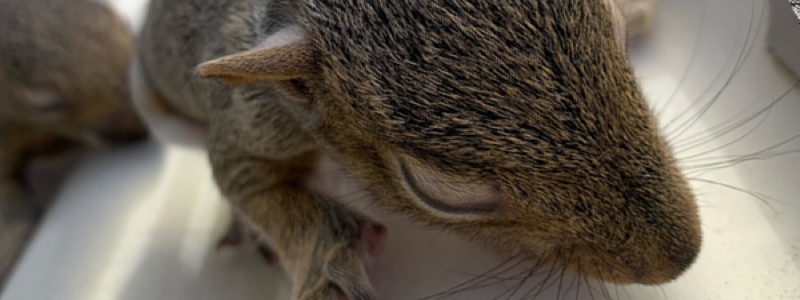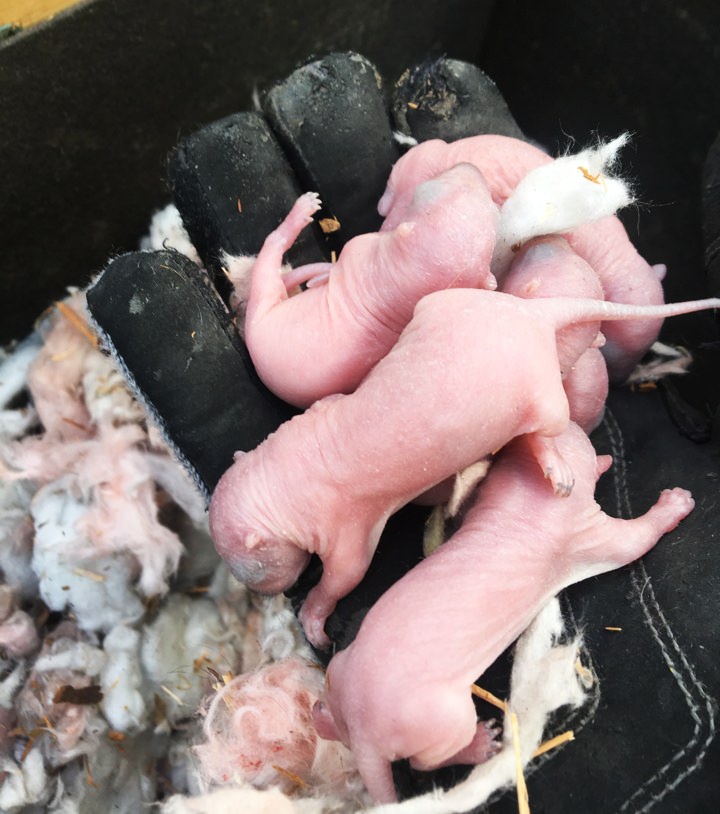
A Mild Winter Means Early Wildlife Baby Births & Sudden Infestations
Posted by Jared Houliston Thursday, February 16th, 2023 | 4,306 Reads
 Are you hearing strange noises in your attic all of a sudden? If so it may be because there’s a mild winter ahead of us and wildlife babies are expected to be born earlier than usual this year.
Are you hearing strange noises in your attic all of a sudden? If so it may be because there’s a mild winter ahead of us and wildlife babies are expected to be born earlier than usual this year.
From raccoons and squirrels to mice and skunks—a sudden increase in sounds in your attic is a sign of an unwanted infestation which should be inspected promptly.
When it comes to mild winters, the formula is a as follows:
(mild winter) + (more food sources) = more access to roam freely which sparks the mating instinct in wildlife.
Key Points in This Article
- Mild Winters and its Impact on Wildlife Birth Rates
- The Yearly Mating Cycle of Raccoons, Squirrels, and Mice
- Common Sounds in the Attic and What They May Indicate
- The Role of Food Sources in Attracting Wildlife to Your Property
- The Dangers Posed by Wildlife Infestations
- Don’t Procrastinate: Why Removing Wildlife Fast is Crucial
- The Importance of Professionally Identifying Wildlife for Removal
- The Important Role of Professional Wildlife Removal
Mild Winters and its Impact on Wildlife Birth Rates
Mild winters can have a significant and observable impact on wildlife birth rates. As temperatures continue to stay warm and consistent, animals start foraging for food and mating earlier than expected. This leads to an increase in the number of births and more wild animals looking for a place to nest over the next few months.
This is where a homeowner’s attic usually becomes the hot spot for raising babies and the beginning of unwanted infestations.
The Yearly Mating Cycle of Raccoons, Squirrels, and Mice
- Raccoons typically mate in January and give birth to litters of 2-5 kits in March.
- Squirrels have a longer reproductive cycle and typically mate in January, giving birth to their first litter in March and usually a second litter is born between July and August.
- Mice/Rats have the most extended reproductive cycle of the three and mate year-round. They’re more active during mild winters because the abundance of food sources increases their chances of survival and the survival of their litters.
These various mating and reproductive patterns can have a significant impact on homeowners because the presence of young wildlife in attics and other structures can lead to property damage and potential health hazards. Wildlife removal companies that understand these yearly cycles can help homeowners take proper preventive measures to keep wildlife from entering their homes.
Common Sounds in the Attic and Which Animals They May Indicate
The common forms of wildlife that may take refuge in attics are raccoons, squirrels, bats, birds, rats and mice. Each of these species have unique behaviours and make distinctive sounds that can help you identify them.
For example raccoons make growling or squeak-sounding noises, grunting and coughing sounds. you’ll hear a lot of thumping because of their weight and most of the noises you’ll hear from them are at night.
Squirrels make a lot of scratching and scurrying noises. They can more easily get around an attic and behind the walls of a home so you’ll hear them scurrying about during the night and day. They’re also quite brave so don’t be surprised if your home isn’t protected and you find a squirrel in your living room.
Bats make high-pitched squeaks and chirps that are rarely heard by humans but when they’re active during the warmer months you may hear squeaking and scratching noises in your walls.
Mice and rats are slightly harder to hear too but they do make scratching and gnawing sounds that can sometimes be heard depending on where in the attic or home they are.
Paying attention to the sounds you hear in your attic can indicate the type of wildlife present but it’s primarily the job of a professional wildlife management company to identify the animal, find out where it is, and take the appropriate removal measures to evict it from your home safely.
The Role of Food Sources in Attracting Wildlife in Mild Weather
Mild winters greatly impact the behaviour of wildlife and their migration patterns. When temperatures are warmer, wildlife are more active and able to move about more freely which increases their chances of finding food sources.
These food sources, such as bird feeders, compost piles, outdoor pet food, etc., attract wildlife to residential areas where they’re inclined to making homes and other structures vulnerable to invasion. The abundance of food availability leads to an increase in the population of these animals which can further lead to potential property damage and health hazards.
If you’ve discovered that there’s a high chance an animal is living in your attic or walls don’t hesitate to call your local wildlife removal company to take the preventative measures to reduce the risk of an infestation.
The Dangers Posed by Wildlife Infestations
A wildlife infestation can pose serious dangers to both the structure of the home and the health and safety of your family. Wildlife like raccoons, squirrels, bats, and mice cause damage to insulation, electrical wiring, and a slew of other damage to many other structural components.
Raccoons, squirrels, bats, and mice are common pests that can transmit diseases and parasites to humans such as raccoon roundworm, rabies, hantavirus, Lyme disease, salmonellosis (birds), leptospirosis (mice, rats and squirrels), and histoplasmosis (bats).
These diseases and parasites pose serious health risks to humans and pets. They can also cause unpleasant odours to appear and produce droppings that contaminate the indoor air quality and pose a risk to people with respiratory problems.
Don’t Procrastinate: Why Removing Wildlife Fast is Crucial
The dangers posed by wildlife in a home can go on unnoticed for years especially if the animals haven’t been discovered in the attic for a long time. It’s quite common that they go unnoticed so it’s important to take quick action to remove them if you have the slightest suspicion they’re there.
We advise you to literally look around your home for signs of wildlife, and listen carefully to the sounds in your home—especially at night.
Delaying the removal process can lead to increased damage to your home and increases the spread of diseases and parasites. The longer wildlife remain in your attic, the more they multiply, which is why prompt removal by a professional is crucial to minimizing these risks and protecting your home and health.
The Importance of Professionally Identifying Wildlife for Removal
Having the wildlife that’s in your home identified by a professional helps determine the best and safest course of action for removal, and it minimizes the risks to both the animal and the homeowner.
Different species of wildlife have different behaviours and habits that affect the identification and removal process. They require different methods for removal and some species are even affected by different laws to follow for removing them.
This is just one of the reasons to choose a professional company and to make sure you’ve done your research before choosing one.
The Important Role of Professional Wildlife Removal
Professional wildlife removal companies actually play a major role in protecting homes and communities from the various dangers and disruptions posed by animal infestations.
Experienced technicians use safe, effective, and proven methods to remove wildlife and prevent future infestations. In so doing, they are effectively protecting the health and safety of homeowners, and helping to maintain a balance in the local ecosystem by relocating wildlife back to their natural habitats.
What Next? Be Proactive
With earlier birth rates there’s a higher chance of wildlife trying to get into your attic or walls, but by being proactive you can have your home protected early. Do a quick home inspection, and keep your eyes and ears open for the signs.
2 Responses to “A Mild Winter Means Early Wildlife Baby Births & Sudden Infestations”
Leave a Reply
Ontario Wildlife Removal Inc. provides wildlife removal and pest control in Southwestern Ontario, including Brantford, Kitchener-Waterloo, Cambridge, Guelph, London, Woodstock, Tillsonburg, Simcoe, Port Dover, Paris, St. George, Six Nations, Caledonia, Burlington, Waterdown, Oakville, Hamilton, Stoney Creek, Grimsby, & Niagara Region. Our methods are safe, humane and environmentally friendly. Call today to book your inspection.
Get a Pest Control Quote
Simply fill in your details below and we'll call you very shortly to discuss your issues.





Hearing noises in the attic!
This is where it starts! If you hear noises in your attic, it could be any animal but usually we’ll find bats, mice, squirrels and raccoons in attics more than the other forms of wildlife. Contact your local wildlife removal company before the problem gets worse!